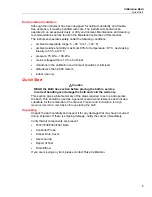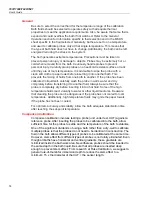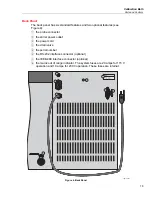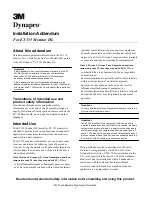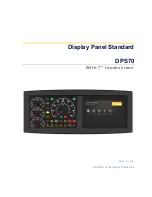
7037/7038/7040/7041
User's Guide
22
General Operation
Bath Fluid
Many fluids will work with your bath. Choosing a fluid requires consideration of
many important characteristics of the fluid. Among these are temperature range,
viscosity, specific heat, thermal conductivity, thermal expansion, electrical
resistivity, fluid lifetime, safety, and cost.
Temperature Range
One of the most important characteristics to consider is the temperature range of
the fluid. Few fluids work well throughout the complete temperature range of the
bath. The temperature at which the bath is operated must always be within the
safe and useful temperature range of the fluid. The lower temperature range of
the fluid is determined by the freeze point of the fluid or the temperature at which
the viscosity becomes too great. The upper temperature is usually limited by
vaporization, flammability, or chemical breakdown of the fluid. Vaporization of the
fluid at higher temperatures may affect temperature stability because of cool
condensed fluid dripping into the bath from the lid.
The bath temperature should be limited by setting the safety cut-out so that the
bath temperature cannot exceed the safe operating temperature limit of the fluid.
Viscosity
Viscosity is a measure of the thickness of a fluid, how easily it can be poured
and mixed. Viscosity affects the temperature stability of the bath. With low
viscosity, fluid mixing is better which creates a more uniform temperature
throughout the bath. This improves the bath response time which allows it to
maintain a more constant temperature. For good control the viscosity should
be less than 10 centistokes. 50 centistokes is about the upper limit of allowable
viscosity. Viscosities greater than this cause very poor control stability and
may also overheat or damage the stirring motor. With oils viscosity may vary
greatly with temperature.
When using fluids with higher viscosities the controller proportional band may
need to be increased to compensate for the reduced response time.
Otherwise the temperature may begin to oscillate.
Specific Heat
Specific heat is the measure of the heat storage ability of the fluid. Specific heat,
though to a lesser degree, also affects the control stability and the heating and
cooling rates. Generally, a lower specific heat causes slightly better control
stability and quicker heating and cooling. With fluids with higher specific heat the
controller may require a decreased proportional band to compensate for the
decrease in sensitivity of the bath temperature to heat input


